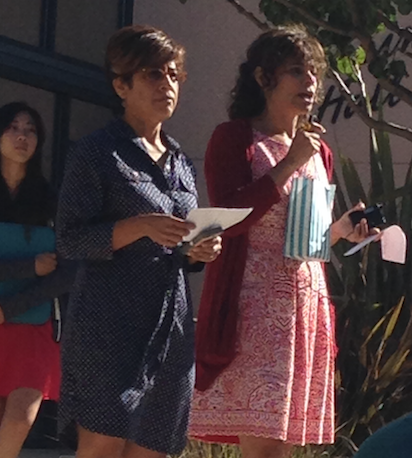Dress code changes lead to open discussion between students and administration

Teachers Pilar Aguero-Esparza and Lola Muldrew announce the dress code forum at a class meeting. The dress code has been a popular point of discussion at the upper school.
Short skirts? Spaghetti straps? Large logos or text? Confederate flags on clothing? These are the issues schools across the country, including Harker, face while creating and implementing dress code policies.
Changes in the dress code, which became effective at the beginning of this school year, generated heated debates and lunch-time conversation throughout the student body and faculty.
Modifications included: the fingertip rule being applied to all skirts, dresses, and shirts; white T-shirts not being allowed; all Harker-affiliated apparel needing to be approved by administration prior to creation; and logos or designs larger than the size of a palm being restricted outside of Harker-affiliated or collegiate wear on T-shirts and sweatshirts.
“I think [the new policy has] really helped improve the look here,” Dean of Students Kevin Williamson said. “I think that conservative, modest attire is something I really want [everyone] to consider when coming into work, not just girls. I’m concerned about the logos, branding, messaging.”
The 2015-2016 dress code was the result of work by a dress code committee that included input from students, parents, and faculty. Revisions included the fingertip rule and the ability for all students to wear t-shirts to class. The revised policy was tested during the second semester of last school year.
The discussion over the dress code, or more specifically about the perception of enforcement of the dress code, ignited debate on both sides of the aisle.
Jessica Skinner (10) voiced her opinion about limits in the dress code changes.
“I believe that we should have a little bit more freedom in the t-shirts that we wear,” she said. “Certain things should be approved like sayings or even pictures instead of having to wear a plain t-shirt.”
Several students were less concerned with the policy itself, but rather focused on the tactics that the administration used to enforce the dress code.
“I believed the old dress code wasn’t too difficult to follow,” Prithvi Gudapati (12) said. “You could express yourself within it. The only issue I see here is enforcement.”
Both students and faculty have repeatedly highlighted the distinction between debate about the dress code policy and the controversy over how it is enforced. A growing concern from students focused on the fact that females were being checked for dress-code violations far more than males were.
Pilar Aguero-Esparza, faculty member of the dress code committee, acknowledged during the meeting that the school’s dress code fell into a conservative vein, stating that the rules were selected to reflect the mission of the school.
“When we put together the dress code, we explicitly told faculty that this is a very sensitive issue,” Aguero-Esparza said. “We really don’t feel comfortable that males could tell females about issues of the dress code.”
The campus’ controversy echoes similar issues at other schools. Articles published earlier this month in The Guardian, NPR, and the Washington Post mention the increasing attention to dress code debates around the country, ranging from prohibition of gang-colors to hate-related symbols at school.
By early September, students and faculty became increasingly polarized over the issue alongside a broadening sense that females were being unfairly “dress-coded.” On Sept. 10, student Gurutam Thockchom (12) created a public Facebook post criticizing the administration’s enforcement strategy of dress code policies, sparking heated debate in the comments section about the roles and rights of administration.
The Thursday-afternoon post garnered over 200 likes. A day later, the Associated Student Body (ASB) council announced that it would hold a dress code forum to promote open dialogue.
“The reason I made it was not to complain,” Gurutam said of his post. “The reason I made it was that there’s something going on that’s invisible to a lot of male members of the community. What my post ended up being was a place where lots of women in the community could talk about their specific experiences of sexualization and sexism in the dress code.”
Williamson and ASB president Michael Zhao (12) moderated the first forum on Sept. 14. About 65 members of the community attended the Monday afternoon discussion in Nichols auditorium.
Molly Wancewicz (11), a student who spoke at the forum, expressed her belief that the administration’s policing was a bigger issue than the dress code itself, referring to administrators handing out detention slips for dress code violations during lunchtime in Manzanita.
“I think that the enforcement is the problem, mainly because the enforcement is what’s really reinforcing the idea that what’s on the outside is more important than what’s on the inside,” Molly said.
The perception voiced by female students that detentions were handed out disproportionately to females differs from the school’s detention records.
The Winged Post requested statistics on the number of detentions served since the beginning of the school year and the violations associated with them.
According to school records up to Oct. 7, 84 students have served detention since the beginning of the school year. Twenty six of these detentions were served for dress code infractions. Of these 26, 20 students violated the dress code’s oversized logo policy.
After the conclusion of the forum, many questions remained unresolved. Some students voiced their opinion that the direction of the forum had been predominantly controlled by male voices.
“To be honest, I expected a different type of discussion from the [first] dress code forum,” said Shannon Hong, Issues Discussion Club president and participant at the forum. “The reason why the post actually went viral was because we wanted to talk about enforcement of dress code, women’s issues. That conversation was overwhelmingly dominated by men.”
As a result, a week later Aguero-Esparza and Dr. Lola Muldrew led a females-only lunchtime discussion on Sept. 23. The forum provided a venue for students and faculty to discuss personal experiences with the enforcement of the dress code and possible ways for teachers to comfortably approach students not in dress code.
At a Sept. 26 NorCal Media Conference at Palo Alto High School, members of Harker Journalism hosted a Dress Code Forum for journalists interested in discussing dress codes at their schools and providing coverage on the topic. About 40 high school journalists filled the room, and each shared stories of their school’s policies and stumbling blocks with regards to dress code implementation.
“It was a very heated discussion. Everyone in the room had something to say,” Kavya Ramakrishnan (12), who moderated the open forum, said. “I was surprised that so many students who felt passionate about the dress code chose to be there. It’s a huge topic at every school right now.”
Estephania Melendez, an attendee of the forum and a student journalist at Salinas High School, commented on her understanding of dress code policies aimed at protecting student safety by reducing gang violence.
“I have a solid red shirt that I wear, which is a fandom shirt for ‘Doctor Who,’ and I don’t wear it often,” she said. “There’s maybe one or two teachers who’ve said, ‘Stephanie, that’s a red shirt, please put on a jacket, we know that you don’t mean anything by it but it’s for your safety,’ which I get.”
In response to feedback, the administration will continue to hold meetings with faculty and students, part of an effort to revise the standing dress code.
“We are taking feedback from the students,” Assistant Head of School Jennifer Gargano said. “It’s obvious that [the dress code] is not 100 percent working. We are not naive enough to think that we are going to come up with a dress code that is 100 percent perfect for everyone. It definitely looks like there is some room for improvement.”
Issues related to student dress and free expression have a long and sometimes contentious history in American high schools. One of the most significant court cases involving students’ rights to free expression involved wearing clothing deemed offensive.
Mary Beth Tinker, a D.C.-based youth rights activist and also one of the plaintiffs in the 1969 Supreme Court case Tinker v. Des Moines Independent School District, wore a black armband to school as a protest against the Vietnam War. After being suspended, she sued the school district and won, with the Supreme Court decision stating in the majority opinion that “It can hardly be argued that either students or teachers shed their constitutional rights to freedom of speech or expression at the schoolhouse gate.”
Tinker, who was an assembly speaker at Harker in 2014, commented in a phone interview about the association between freedom of expression and an individual’s presentation of themselves in their dress.
“They are completely intertwined, because what you wear is an expression. It goes all the way from what colors you pick out and what type of clothes you have, to whether or not you want to have messages explicitly on your clothing or on yourself, like buttons or t-shirts for sake of example,” she said. “It’s a huge part of free speech.”

Sharanya Balaji (12) is the Editor-In-Chief for Harker Aquila and has been on staff for the past three years. Additionally, during her freshman year she...

Vivek Bharadwaj (12) is the co-Editor-In-Chief for the Winged Post. His favorite subject in school is computer science, and he enjoys swimming and watching...

Kavya Ramakrishnan (12) is the managing editor of the Winged Post. This is her fourth year on staff, having previously held the positions of reporter and...
Meena Gudapati (12) is the Editor-in-Chief of Harker Aquila. Her favorite part of journalism is making her humorous podcast "Get Skool'd" and writing interesting...




![LALC Vice President of External Affairs Raeanne Li (11) explains the International Phonetic Alphabet to attendees. "We decided to have more fun topics this year instead of just talking about the same things every year so our older members can also [enjoy],” Raeanne said.](https://harkeraquila.com/wp-content/uploads/2025/10/DSC_4627-1200x795.jpg)


















![“[Building nerf blasters] became this outlet of creativity for me that hasn't been matched by anything else. The process [of] making a build complete to your desire is such a painstakingly difficult process, but I've had to learn from [the skills needed from] soldering to proper painting. There's so many different options for everything, if you think about it, it exists. The best part is [that] if it doesn't exist, you can build it yourself," Ishaan Parate said.](https://harkeraquila.com/wp-content/uploads/2022/08/DSC_8149-900x604.jpg)




![“When I came into high school, I was ready to be a follower. But DECA was a game changer for me. It helped me overcome my fear of public speaking, and it's played such a major role in who I've become today. To be able to successfully lead a chapter of 150 students, an officer team and be one of the upperclassmen I once really admired is something I'm [really] proud of,” Anvitha Tummala ('21) said.](https://harkeraquila.com/wp-content/uploads/2021/07/Screen-Shot-2021-07-25-at-9.50.05-AM-900x594.png)







![“I think getting up in the morning and having a sense of purpose [is exciting]. I think without a certain amount of drive, life is kind of obsolete and mundane, and I think having that every single day is what makes each day unique and kind of makes life exciting,” Neymika Jain (12) said.](https://harkeraquila.com/wp-content/uploads/2017/06/Screen-Shot-2017-06-03-at-4.54.16-PM.png)








![“My slogan is ‘slow feet, don’t eat, and I’m hungry.’ You need to run fast to get where you are–you aren't going to get those championships if you aren't fast,” Angel Cervantes (12) said. “I want to do well in school on my tests and in track and win championships for my team. I live by that, [and] I can do that anywhere: in the classroom or on the field.”](https://harkeraquila.com/wp-content/uploads/2018/06/DSC5146-900x601.jpg)
![“[Volleyball has] taught me how to fall correctly, and another thing it taught is that you don’t have to be the best at something to be good at it. If you just hit the ball in a smart way, then it still scores points and you’re good at it. You could be a background player and still make a much bigger impact on the team than you would think,” Anya Gert (’20) said.](https://harkeraquila.com/wp-content/uploads/2020/06/AnnaGert_JinTuan_HoHPhotoEdited-600x900.jpeg)

![“I'm not nearly there yet, but [my confidence has] definitely been getting better since I was pretty shy and timid coming into Harker my freshman year. I know that there's a lot of people that are really confident in what they do, and I really admire them. Everyone's so driven and that has really pushed me to kind of try to find my own place in high school and be more confident,” Alyssa Huang (’20) said.](https://harkeraquila.com/wp-content/uploads/2020/06/AlyssaHuang_EmilyChen_HoHPhoto-900x749.jpeg)


